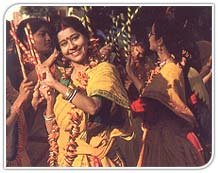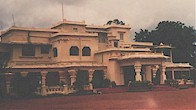|





| |
Economics
Department Survey 2003


The study of equilibrium income and its elevation on a level as broad as the country is taught and learnt well in, what is often termed by one of our professors as,
' The confines of the class '
Thus, what we fail to experience and live is our very own ground roots, from where we have taken birth and by whose help we have grown. This identity is in fine conjunction with our undergraduate study of the subject of economics and it is this conjunction that provides us with a rare chance of answering the call within us to return, once again, to our roots. Further, we take it upon ourselves to go through this trip with a mission of searching the answers to development and growth, hand-in-hand.
The destination is set at Shantiniketan and the rural pockets to be surveyed are Kasba and Surul , both having the distinction of being the most developed villages under their Panchayat for agriculture and handicrafts, respectively.
We travel to land of knowledge and awakening, the land of Tagore. Here is the world-famous University of Tagore - Vishwa Bharati. Classes are held in the open air with the teacher and pupil both relating to Mother Nature and all her glory.


..

Shantiniketan is a famous university town in West Bengal. It has become a tourist spot because of its association with Gurudev Rabindranath Tagore (1861-1941), one of Bengal's greatest figures. Of course the natural charm of Shantiniketan is a major draw in itself.


Another interesting feature about Shantiniketan is that splendid sculptures, frescoes, murals and paintings of Rabindranath, Nandlal Bose, Ramkinkar, Bindobehari Mukhopadhyaya and others adorn the campus.
Shantiniketan is also famous for its various festivals, which mark the changing seasons. The major festivals are Poush Mela (December), Maghotsab (February), Basanta Utsab (March), Varsha Mangal (July-August) and Sharodutsab (Oct-Nov).


 .... ....
 Rabindranath Tagore's Vishva Bharati formally came into existence on the 23rd of December 1918. However its origin dates back to 1863 when Maharishi Debendranath Tagore built a garden house in Birbhum, to relax and meditate. This was Shantiniketan. It was here, thirty-six years later that Rabindranath Tagore started a school, then called Brahmacharyashrama. Since then it has grown organically to provide quality education at not only secondary and higher secondary levels but also still higher levels in a wide range of subjects like science, Fine arts, Performing Arts, Agricultural Studies etc. interested students have to sit for an aptitude test and only fourteen lucky students are selected per stream per year- eight for Diploma courses and six for certificate courses. A special feature of the Vishwa Bharati is that it is a self-financed institution. Apart from the fees from students, its income is generated from the goods produced here, which are sold in the annual Poush Mela. Future plans of the institute include job placement, campus recruitment, etc.
Rabindranath Tagore's Vishva Bharati formally came into existence on the 23rd of December 1918. However its origin dates back to 1863 when Maharishi Debendranath Tagore built a garden house in Birbhum, to relax and meditate. This was Shantiniketan. It was here, thirty-six years later that Rabindranath Tagore started a school, then called Brahmacharyashrama. Since then it has grown organically to provide quality education at not only secondary and higher secondary levels but also still higher levels in a wide range of subjects like science, Fine arts, Performing Arts, Agricultural Studies etc. interested students have to sit for an aptitude test and only fourteen lucky students are selected per stream per year- eight for Diploma courses and six for certificate courses. A special feature of the Vishwa Bharati is that it is a self-financed institution. Apart from the fees from students, its income is generated from the goods produced here, which are sold in the annual Poush Mela. Future plans of the institute include job placement, campus recruitment, etc.

|
![]()